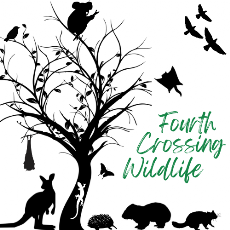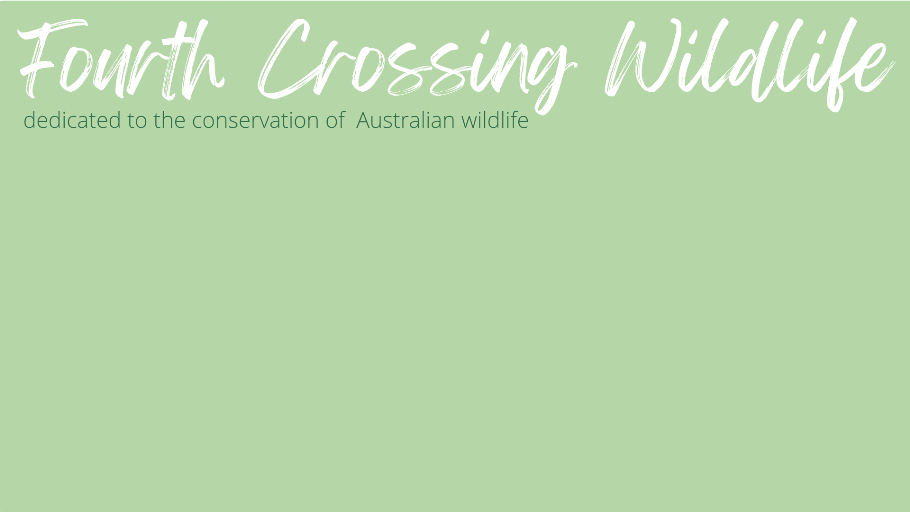Stories
The Sassiest Wallaroo
by Linda Dennis
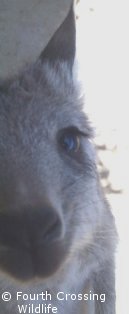 Sassy wanted to be close-up and personal! 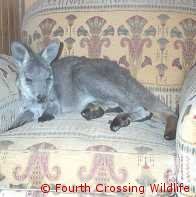 We often found Sassy that had snuck into the loungeroom. 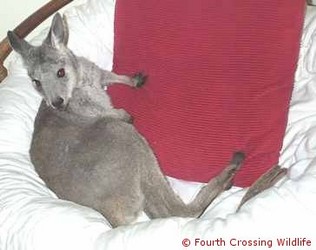 Sassy with "her" pillow. 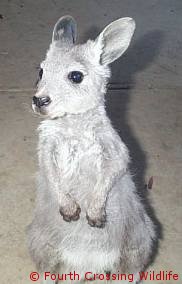 Outside at last! 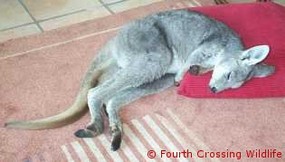 Sassy, back inside again. 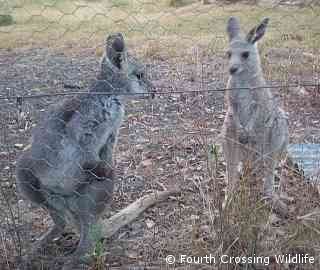 Sassy and her Eastern Grey Kangaroo friend, Lilly. 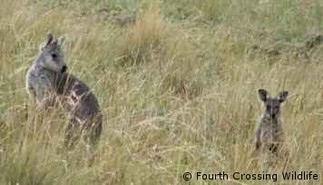 Sassy and her first joey, Voomp. 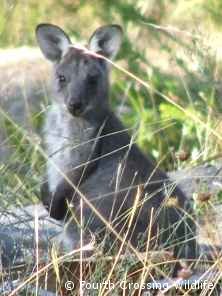 Our grandchild, Voomp. 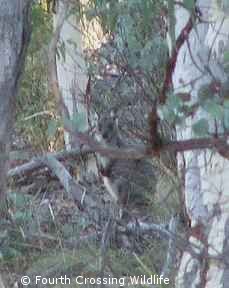 Voomp, hiding well. 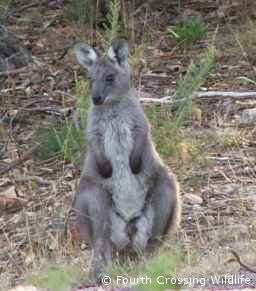 Voomp, showing his little black paws just like his dad, Sox. 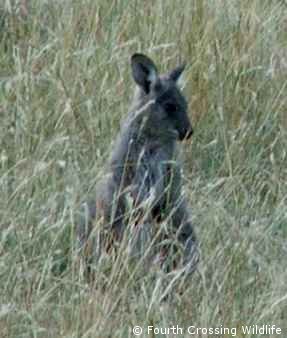 So proud that our girl Sassy not only made it back into the wild, but socialised, bred and became a great mum. | Meet Sassy, an Eastern Wallaroo - Macropus robustus robustus. Eastern Wallaroos look similar in appearance to an Eastern Grey Kangaroo (to the inexperienced macropod "watcher") but with a shaggier and denser coat and a bulkier, heavier set body. Females are pale grey and males are dark grey. Miss Sas came to us to ready her for release back into the wild. She had spent quite a few months with another wildlife carer who lived in town. At first she was pretty pee'd off because she was quite settled with her other "family" and didn't much like me or Todd. Her name is indicative of her nature - quite a tempestuous little thing, as many wallaroos are! In the early days she would often give us a belting and her nips were quite sharp. As she settled in though, her boxing turned into a sport and the bites weren't nearly so aggressive - and my bruises weren't nearly so black! Thankfully, it didn't take too long for her to settle down. She made good friends with Maddy and Marshall (Swamp Wallabies) and Google, Floss, Lilly and Rustle (Eastern Grey Kangaroos). Being part of a mob -albeit an assorted mob! - helped her recognise that she was indeed not human but a macropod! You see, when Sassy came to us she was quite humanised, after living in a house with children and domestic animals. She was accustomed to sleeping with the family and, so I was told, was often found curled up on one of the beds. She was used to having the pet cat and small dog as play companions. It's impossible to expect a native animal that has been raised by humans not to be touched by "humanisation" in some way. The orphans are not raised in a natural environment so it's not realistic to think that they will not be affected to some degree. However, there are different degrees of humanisation and I do believe that the word is used too often. At the good end - and what I don't actually believe should be classed as humanisation - is when an animal is not frightened of its carer, their human "mum or dad", but is wary of all strangers, human and animal alike. When soft releasing, this is actually what we want, so that the animal will have support as it slowly returns to the wild. At the bad end - what is true (and potentially deadly) humanisation - is when an animal is frightened of no-one and nothing. Sassy craved our attention and wouldn't accept she was a wallaroo, but she also "talked" with any of our visitors. She had no fear. She'd be a tough challenge to return to the wild - do-able, but with a hell of a lot more work. It took us many many months to convince Sassy she was a wallaroo and not a "humaroo" or "wallaruman"! At first she didn't particularly like the outdoors and would constantly disappear in the house. On many occasion we found her curled up in one of our pappasan chairs or on the lounge chair or lying, quite contentedly, in the bedroom. A habit we found hard to break. Turning her back into a wild wallaroo was proving to be quite a challenge. "Dehumanizing" a native animal that has been raised by humans varies from animal to animal. Some take a few months, others take several months - even years. To dehumanise an animal is to make it aware of its own species, to ensure that it can forage for its own food without "human parent" support and that it is frightened of strangers. With Sassy it was an incredibly slow process. Moving her from the house to the yard was difficult and at times stressful for both her and us. However we tried to accommodate her need to be near us and her love of the creature comforts for as long as we could. For the first month or so we moved Sassy outside during the day but allowed her to come inside of a night time. Some of that time would be spent with us, giving her the cuddles she craved, but she would be confined to the laundry - water and grass in abundance - when we retired to bed. To make the transition easier for her we gave her her own pillow - the red one that she found on the pappasan chair was claimed! It had her scent on it and it gave her comfort when we wouldn't allow her access to the rest of the house. During her time outside, the pillow went with her. The scary big wide world wasn't nearly so bad with her pillow close by! Slowly but surely Sassy gained confidence in the outdoors. We removed her pillow for longer periods and were rewarded by seeing her lying in a dirt patch that had been created by the other macropods. Some weeks later we opened up the back house yard increasing the size of the area to about one acre. She, and the other macropods in care, took the change quite well. With her new found confidence we moved her outside permanently, but returned her pillow to her which was left on the verandah for her when things got a little too scary, but she was using it less and less. Her return to the wild was finally looking promising. She started spending more and more time in the yard with the other macropods and needed our company less often. Unfortunately though we experienced a set back when Todd and I took a week off and went away for a short holiday. During our absence we arranged for other wildlife carers to come to our property to feed and check on the macropods. I'm not sure if it was a particular event, or multiple carers having contact with the animals, but Sassy and Maddy were quite stressed when we returned. Having a release site puts a fair amount of burden on a volunteer wildlife carer. In town carers usually hold animals that are quite small, usually still in pouch. If needed, the animal can be moved to another carer for babysitting. Obviously at a release site the animals in care can vary from tiny to juveniles ready for release. When we go away it isn't possible to move a bigger animal elsewhere, this would cause much stress to the animal and would certainly put a major set back in the release process. During this getaway our wonderful babysitter, Murray, couldn't care for the animals so I had to organise for different carers to come on different days - not the best situation for a native animal, but I had no other choice. I'm a volunteer but I still need a break once in a while and because I live out of town I couldn't get one carer to make the trip every day, that simply isn't a reasonable request. When we returned Sassy was again craving our company and she literally tried running through the sliding door to get to us. Although she was really too big to be back in the house again, we succumbed to her perseverance and allowed her time inside. I preferred her release be put back a month or so and have her with us where she was content than risk her damaging herself in the effort to reach us. She had already taken a patch of fur and skin off her nose in her stubborn attempt to be with us. On the other extreme Maddy didn't want a bar of us when we returned. She was quite highly strung and darted away from us when ever we tried to approach her. The day after we returned we encouraged her over with a cashew nut (her favourite!) and checked her over. No physical damage thankfully, just the absolute desire to be free! A few days after our return we opened up the back paddock which increased the size from one acre to five. We left the house yard open for them for a while so that they could freely come and go and be near us if they felt insecure for any reason. About one month later we closed the gate to the house yard but continued to visit the macropods daily in the paddock. Sassy was again non too impressed and literally tried barging through the fence. The gate was opened again and Sassy would visit us every other day. Eventually things started looking better again when she spent more and more time at the bottom end of the paddock with the other macropods. One particular night I remember well. We were in the middle of a chaotic storm - massive bolts of lightening followed by the immediate and loud clap of thunder. The storm was too furious for us to venture out so it wasn't until morning when all was quite that we went in search of the macropods to see how they had weathered the storm. Many animals hate storms, particularly strong wind as they cannot hear approaching danger, macropods are no exception. Their huge radar ears, which normally pick up sounds humans can't hear, are rendered quiet useless in windy weather, as are their scenting abilities. The storm we had endured the previous night would have put the macropods into panic mode and as a consequence when we went to check, Sassy was no where to be seen. Todd and I started searching for her in the paddock. Nothing! We then went out into to the main farm paddock and surrounding bush and called her name. Out of the bush came a grey bolt of lightening, and headed straight for Todds open arms! She clucked and chattered to us and I'm sure she was telling us of her ordeal! Luckily she received no injuries from the jump over the fence (the only way we figured she could have gotten out), but she was quite agitated so we brought her inside for a water cracker treat! Thankfully the storm didn't cause too much of a set back - we'd had too many of them with Sassy already! She was returned to the paddock and the next stage of her release process went well. Finally the gate to the big wide world was opened and the macropods had access to all areas of the farm. The Eastern Grey Kangaroos we had in care were the first to go, Sassy took a lot longer. Although all of the macropods continued to be support fed they gradually got further away and preferred each others company to ours. For many months after, we had the immense pleasure of seeing them out in the paddocks and occasionally they'd come home for a visit and for treats and a scratch under the chin. As time wore on they became less trustful of humans to the point where they would even run from us if we went to close to them in the paddock. Around the house yard is the only place where we had the opportunity for those very special reunions. And the good news? After several months, Sassy had a small joey in her pouch! From the size of the lump we assume it is still a pinkie, ears up and eyes open, around 3-4 months old. Raising orphaned native animals is never easy. There are hurdles along the path, illness and diseases to combat and unwilling animals to "dehumanise". As shown is Sassy's story it can sometimes take a lot longer to get some animals "back to bush" but it is certainly worth it in the end! I've said it before and I'll say it again - seeing a native animal that I have raised or rehabilitated return to the wild is one of the most awesome feelings I will ever experience. The new generation More months passed and we had the super duper immense pleasure of seeing Sassy's offspring, a joey at foot - a boy!! We named him Voomp, cos that's the sound he made as he followed closely at his mums heals when they streaked through the bush. And what a wonderful sight - what proud grandparents we are! There is a big old male wallaroo that lives on our property, and we called him Sox because of his really black paws and feet. We think Sox is Voomps daddy as Voomp also has the black paws that really stand out from his dark grey coat. He's going to grow into a very handsome man! And so, we did it! What a spectacular success story. Not only has Sassy returned to the bush, she has socialised, bred, and is an amazing mum. How proud am I!! |
